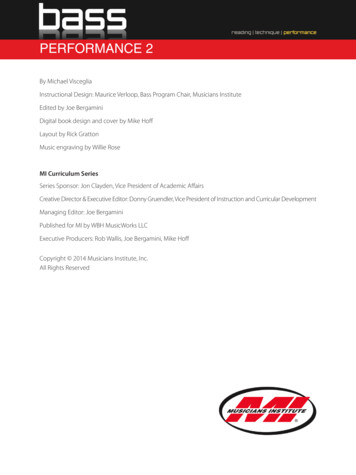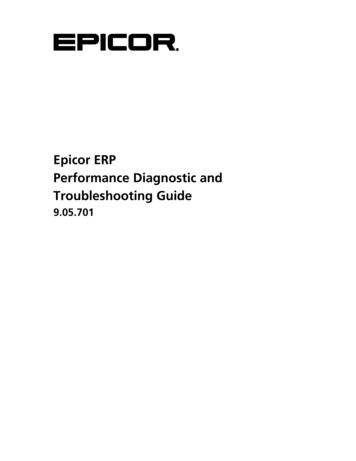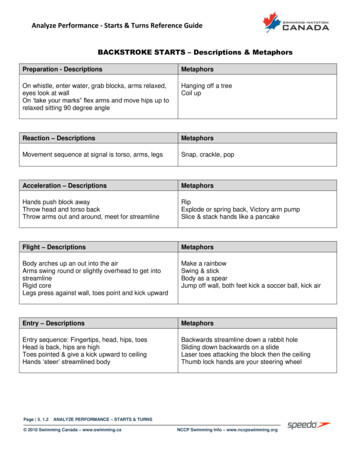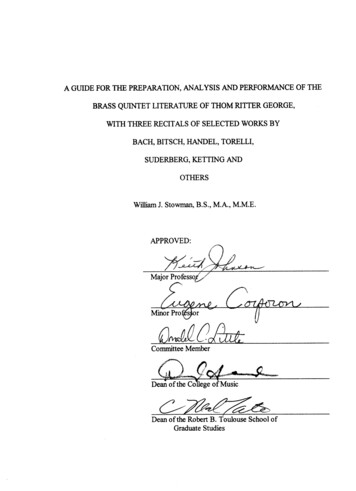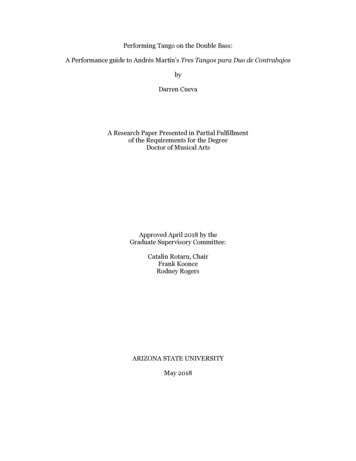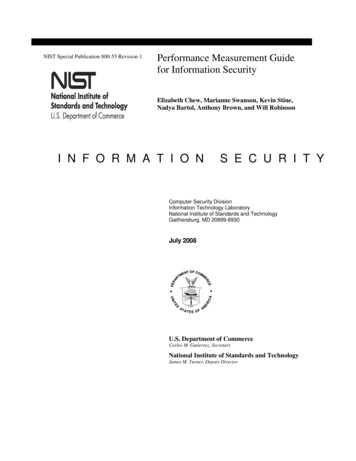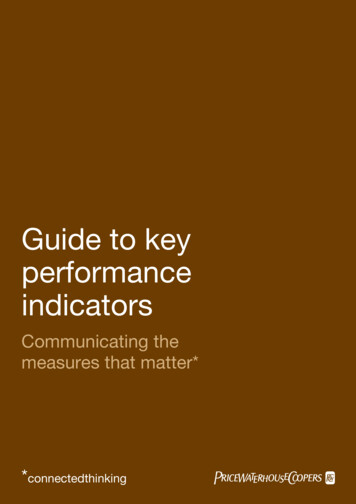
Transcription
A PERFORMANCE GUIDE TO THE TRUMPET REPERTOIRE OF JACQUESCASTÉRÈDE FOCUSING ON BREVES RENCONTRES ANDCONCERTINO FOR TRUMPET AND TROMBONEEtienne Denis Stoupy, BM, MMDissertation Prepared for the Degree ofDOCTOR OF MUSICAL ARTSUNIVERSITY OF NORTH TEXASMay 2011APPROVED:Keith Johnson, Major ProfessorClay Couturiaux, Committee MemberJohn Holt, Committee Member and Chair ofthe Division of Instrumental StudiesLynn Eustis, Director of Graduate Studies inthe College of MusicJames C. Scott, Dean of the College of MusicJames D. Meernik, Acting Dean of theToulouse Graduate School
Stoupy, Etienne Denis. A performance guide to the trumpet repertoire of JacquesCastérède focusing on Brêves Rencontres and Concertino for Trumpet and Trombone. Doctor ofMusical Arts (Performance), May 2011, 26 pp., 20 musical examples, discography, bibliography,25 titles.Jacques Castérède’s works for brass are monumental and demand extreme agility fromthe performers. Many brass players are familiar with the Sonata for Trombone, but Castérède’strumpet repertoire has not been as thoroughly considered. Due to the lack of scholarly works andrecordings of Jacques Castérède trumpet repertoire, a study is necessary to aid its performance.The study is based on performance analysis and interviews with the composer. The first chapterprovides information on the composer’s life. The second and third chapters are performanceanalysis of Brêves Rencontres and Concertino for Trumpet and Trombone. These two chaptersalso discuss rehearsal technique and sound concept. The performance guide takes place inchapter 4. This chapter gives specific indications on articulation, range and mute choice.
Copyright 2011byEtienne Denis Stoupyii
ACKNOWLEDGEMENTSFirst, I would like to thank Jacques Castérède for taking the time to answer my questions.His contribution gives this study another dimension and demonstrates a friendly relationshipbetween composer and performer.My sincere thanks to the performers that will assist me in my recital: Mark Holley andGabriel Sanchez. Their hard work and talent will benefit this project.Finally, I would like to thank my mentor and teacher, Professor Keith Johnson, whoseguidance and encouragement were exemplary and inspired me to be a better musician andteacher.iii
TABLE OF CONTENTSPageACKNOWLEDGEMENTS . iiiChapters1.INTRODUCTION .1Purpose.22.BREVES RENCONTRES .3Performance Analysis of the Divertissement .3Performance Analysis of the Pavane .5Performance Analysis of the Scherzo .83.CONCERTINO FOR TRUMPET AND TROMBONE.10Performance Analysis of the Allegro Energico .10Performance Analysis of the Andante Sostenuto .12Performance Analysis of the Allegro .134.PERFORMANCE GUIDE.16Articulation .16Wide Intervals .17Endurance .18Mute Selection .195.CONCLUSION .21APPENDIX: INTERVIEW WITH JACQUES CASTÉRÈDE .22BIBLIOGRAPHY .25iv
CHAPTER 1INTRODUCTIONJacques Castérède (1922-), a student of Olivier Messiaen, is a prolific French composerwho has composed for nearly every instrument and ensemble. At the age of eighteen, Castérèdebecame a student at the Paris Conservatory. By 1953, Castérède had received first prizes fromthe Conservatory in piano, chamber music, analysis, composition and harmony classes. In 1953,he received the distinguished Prix de Rome in composition awarded by the French governmentfor his cantata, “La Boite de Pandore.”1 According to Claude Chamfray, this cantata presentsfour characteristics of French music: panache, melodic sense, distinction and clarity.2Very few scholarly works are written about Castérède’s trumpet repertoire. In addition,there exists only one commercial recording of the Brêves Rencontres and the Concertino forTrumpet and Trombone. On the other hand, his well-known Sonatine for Trombone, has beenrecorded several times and is assimilated into the trombone repertoire. In 1965, Howard JohnScheib published, as part of his master’s degree in theory from the Eastman School of Music, ananalysis of Castérède’s Sonatine for Trombone and Piano. In this document, Scheib provides adetailed harmonic and melodic analysis of the piece. The Sonatine has much in common withCastérède’s Concertino for Trumpet and Trombone3. The Concertino is in fact a re-arrangementby the composer of the Sonatine for trombone. Scheib describes Castérède’s compositional styleas highly contrapuntal using canonic imitation, fragmentation and diminution. His analysis of1Gérard Condé, "Castérède, Jacques." Oxford Music /article/grove/music/05130 (accessed September 1, 2010).2Claude Chambray, “Remise des recompenses des Grand Prix de Rome.”Le Guide du Concert (November 20, 1953).3Howard John Scheib. An analysis of the “Sonatine for Trombone by Jacques Castérède.” M.A. diss.,University of Rochester, 1965. Retrieved January 18, 2011, PublicationPublicView.action?institutionalItemId 237 (Publication NoML95.2 .S3184).1
the Sonatine reveals many aspects of Castérède’s craftsmanship such as ostinato rhythmic andpentatonic scales.4Denisse Claisse, who published Theorie de la Musique par Jacques Castérède, describesCastérède as an independent composer who “conjugates” atonal and tonal writing often logicallyorganized by chromatic modes and creating consonant and dissonant chords.5PurposeThe French repertoire for trumpet is extensive, although few pieces for trumpet byJacques Castérède are performed or recorded. The goal of this project is to provide detailedperformance practice guidelines that are primarily based on interviews with the composer. Theperformance guide gives stylistic directions on Brêves Rencontres and Concertino for Trumpetand Trombone. These pieces represent two different genres of Castérède’s trumpet writings.Brêves Rencontres is a solo piece written specifically for trumpet, while the Concertino is achamber piece involving trumpet and trombone soloists. The study and the comparison of thetwo pieces help to provide a better understanding of Castérède’s trumpet repertoire.4Howard John Scheib, 109.5Denisse Claisse, Theorie de la Musique par Jacques Castérède, Paris: Billaudot, 2002, 23.2
CHAPTER 2BREVES RENCONTRESBrêves Rencontres was composed in 1965 as the trumpet piece imposed by the ParisConservatory. Brêves Rencontres can be translated as “brief meetings.” Jacques Castérèderevealed that he chose this title because he wanted to depict the time restriction established bythe Paris Conservatory competition6. The piece contains three short movements namedDivertissement, Pavane and Scherzo. The first movement, called Divertissement, echoes thecharacter of the “Divertissement” of the seventeenth century.During this era, a Divertissement was an instrumental interlude that usually featured a dance or arejoicing theme.7Performance Analysis of the DivertissementThe form of this divertissement is a sonata form with an A theme opening the exposition(m.1-6) and recurring in the recapitulation (m.86-91). Theme B is based on a short motivecontouring G without establishing G major. These two themes receive many variationsthroughout the movement and reveal a high level of counterpoint. This distinctive feature ofCastérède’s craftmanshift shapes the entire divertissement.Example 1a: A theme6Jacques Castérède, Interview by author via email, Denton TX, June 22, 2010.7James R. Anthony and M. Bartlet. "Divertissement." In Grove Music Online. Oxford Music /article/grove/music/07865 (accessed January 11, 2011).3
Example 1b: B themeAccording to Leon Dallin, imitative procedure is divided into two sections: the directimitation and the modified imitation.8 Castérède uses both techniques throughout the entiremovement. In Example 2a, Castérède transposes one octave lower than the original theme usingthe direct imitation of the A theme. In Example 2b, Castérède transposes the B theme a minorthird higher and contours Bb using a modified imitation technique.Example 2a: A theme (direct)Example 2b: B theme (modified)Castérède also uses elaborated counterpoint between the piano and the soloist providingtwo equal solo parts concerting with each other. In the Example 3a, the piano part interfacesusing the B theme echoing the solo part.8Leon Dallin, Twentieth Century Composition: A guide to Materials of Modern Music, W.C. BrownCompany, Publishers. Dubuque, IA 3rd ed. 1974, 65-67.4
Example 3a: B theme in piano partAnother characteristic of this movement is the extensive use of mixed-meter. During hisfirst interview, Monsieur Castérède was asked about his musical influences while composing forbrass. Castérède cited his inspiration from “composers of the twentieth century such as IgorStravinsky, Darius Milhaud and Arthur Honegger”9. In the chapter on metric shift, Dallin refersto Stravinsky’s “Rite of Spring” and describes the mixed-meter in this piece as “exciting andalmost daring.”10 The excitement of the mixed-meter relates perfectly to the title of thisDivertissement.Performance Analysis of the PavaneAccording to Donald Jay Grout and Claude V. Palisca, a pavane is originally a sixteenthcentury dance used in the French court.11 During this era, the pavane was a slow dance usingduple meter. In the twentieth century two French composers, Maurice Ravel and Gabriel Fauré,composed pavanes. Gabriel Fauré’s Pavane and “Pavane pour une infante défunte” preservesthe slow pace of the dance and the duple meter but expresses a more melancholy affection thatturns away from the sixteenth century dance.9Jacques Castérède, interview by author via email, Denton TX, June 22, 2010.10Leon Dallin, Twentieth Century Music Composition : A guide to Materials of Modern Music by LeonDallin, W.C. Brown Company, Publishers Dubuque IA 3rd ed, 1974, 65.11Donald Jay Grout, A History of Western Music, revised édition,W.W. Norton, New York, 1973, 114.5
Castérède’s Pavane uses the same slow duple meter as Ravel and Fauré. Differing fromthe first movement, the trumpet part has the primary role and plays the melody while the pianoprovides harmonic support of the line. The melody uses a modal color underscoring thePhrygian mode (E mode). The dynamic is soft and challenging for the soloist because themelody moves freely in the high register of the trumpet. In addition to the high range, Castérèdeindicates to maintain a soft dynamic throughout the movement (senza crescendo).Example 4a: PavaneThe middle section of the movement requires a straight mute, using the indication “enlaissant chanter le piano,” which means “allow the piano to sing” (see Example 4b). During thissection, the piano exposes the main theme while the trumpet provides the countermelody, playedwith a very soft mute. Both performers must pay attention to the balance so that the main themeexposed by the piano is not carried away by the trumpet countermelody. The indication “endehors” on the piano part means “play out” and will help the pianist to understand the soloisticrole of the piano in this passage.6
Example 4b: middle sectionThe last section of the movement requires the use of a cup mute. For this section thetrumpeter needs to find a soft cup mute that plays in tune in all ranges, especially with the lastascendant arpeggio dying away on a high G (see Example 4c). The tendency for brass players isto crescendo on an ascendant melodic line because the player must blow faster air to reach ahigher range. Since Castérède uses a decrescendo on ascendant melodic line, the trumpeterneeds a great embouchure and steady air control to maintain the melody in tune. Keith Johnsonin his chapter on the upper register, advises players to practice such passages on themouthpiece.12 For this last phrase, practicing a C major arpeggio on the mouthpiece willencourage the player to listen carefully for the tuning of each the intervals without the distractionof the instrument.Example 4c: C arpeggio12Keith Johnson, Brass Performance and Pedagogy, Pearson Edition, New Jersey, 2002, 41.7
Performance Analysis of the ScherzoAccording to Tilden A. Russell and Hugh Macdonald, a scherzo is: “a quick and lightmovement or piece, . which replaced the traditional Minuet is the 18 century.”13 Scherzo is anItalian word that can be translated as “joke” or “game.”Castérède’s Scherzo can be describes as a fast and light movement. The leggiero markingindicated with p, confirms Castérède’s intention of a light and delicate movement (see Example5a).Example 5a: Scherzo opening them
On the other hand, his well-known Sonatine for Trombone, has been recorded several times and is assimilated into the trombone repertoire. In 1965, Howard John Scheib published, as part of his master’s degree in theory from the Eastman School of Music, an analysis of Castérède’s Sonatine for Trombone and Piano. In this document, Scheib provides a detailed harmonic and melodic analysis of .
